Ready to Ride
Mustang adoptions draw crowds

LIFESAVING MEASURES GHOST TOURS


Mustang adoptions draw crowds


By Shirley Bloomfield, CEO NTCA–The Rural Broadband Association
In Washington, D.C., we often talk about the new grant programs that are going to help bridge the digital divide in our country. But I want to highlight what I believe has been the most successful rural broadband initiative, the federal Universal Service Fund. So, what is the Universal Service Fund? The Communications Act of 1934 included language that said all Americans should have access to “rapid, efficient, nationwide communications service with adequate facilities at reasonable charges.” Today, the USF is the main federal program helping rural consumers connect to services comparable in price and quality to those in urban areas. This makes services more affordable for low-income families and supports critical connections for schools, libraries and health care facilities in rural communities by offsetting the high cost of building and managing rural communications networks.
There is one big difference that sets the USF apart from many of the new grant programs: The USF not only supports the construction and deployment of networks but also the maintenance of those networks. It helps ensure that these networks are maintained and sustained so Americans continue to make use of broadband long after the last shovel is put down.
An NTCA survey found that without the High-Cost USF program all rural consumers will pay at least $100 more per month for their broadband service. And the viability of some rural broadband networks would be at risk, as the operations costs and repayment of the loans needed to build them cannot be covered.
NTCA is committed to efforts to preserve the USF so that the mission of universal service for all Americans can be fulfilled.
Each month Nielsen, a company that has long tracked viewership habits across a range of media, updates The Gauge. The report offers a snapshot of how various forms of media are consumed to create a picture of the media landscape.
Several key trends shaped the streaming results, such as June marking the end of the school year and start of school breaks, which led viewers 17 and younger to drive the largest upticks in TV usage across all ages.
As a result, this June streaming topped the earlier viewership record set by cable for that month in 2021.



9.9%
8.4% Other streaming: 6% Prime Video: 3.1% Hulu: 3% Disney+: 2% Tubi: 2%
Roku Channel: 1.5% Max: 1.4% Peacock: 1.2%
1.1% Pluto
0.8%
Source: Nielsen The Gauge







About two-thirds of Americans rely on some form of contact lenses or glasses to correct nearsightedness, farsightedness and more. Then there are eye injuries and diseases like glaucoma that can diminish sight, and the inevitable process of aging can also cause a slow decline in eyesight.
In an increasingly online world—where vital information is often communicated using text on screens—people with diminished vision can struggle. However, there are resources available to help those with impaired sight, and even blindness, interact online.
For example, the Americans with Disabilities Act requires all websites to be accessible to everyone. While not every website is ADA compliant, sites for government agencies, banks and larger organizations are. The basic tools you need are free and as handy as web browsers like Chrome, Edge, Firefox and Safari.
BROWSER BY BROWSER
Microsoft’s Edge browser scores well for assistive technologies. It lets users













increase the size of text and get image descriptions for screen readers. Also, a simple keyboard command—Ctrl+Shift+U on PCs and Shift+Command+U on Macs—signals the browser to read the current webpage aloud. Most other browsers require users to go into system preferences or use an extension for screen readers.
Meanwhile, Chrome’s TalkBack screen reader adds spoken, audible or vibration feedback to your device. While the browser does not have a way to change the look of text, it does have extensions that allow users to customize their browsers to control visual clutter.
Google, the maker of Chrome and a popular search engine, has an awardwinning disability employee resource group and says it is committed to hiring employees with disabilities. That commitment also helps it find ways to make its site more accessible.
Like Chrome, Apple’s Safari comes with its own screen reader, VoiceOver. Users can choose the voice they find most pleasing and set the speech speed. It also lets users increase contrast, zoom in and
remove ads and distractions.









Firefox allows users to adjust the settings so every site has the same font, type size and color to enhance the ease of reading. It also has extensions for changing text to speech and making bookmarks larger, among other things.
While users may need a sighted person to set up the assistive features, modern technologies unlock the world to more people than ever.
If you venture into the world of social media—and most people do—you’ll cross paths with personalities known as influencers. From social media platforms like Facebook and X to video sites such as YouTube and TikTok, online personalities have the power to generate attention. With attention comes income, often six figures or more.

CHARLIE BORING CEO
These people, and they can range wildly in accuracy and professionalism, seem to touch on every possible topic: lifestyle, health, politics, sports, entertainment and just about anything else. They can attract millions of eyeballs, and some of the largest, most visible companies advertise on their channels.
I don’t mean to imply this is a new trend. It’s not, at all. However, as other types of media fall more into the background, online influencers continue to have greater reach and, well, influence. But in our busy and often highly online lives, we shouldn’t lose sight of the other influencers around us. You don’t have to look far, either. One of the things I enjoy about our community, and this is true of many rural places like ours, is that there are individuals who make a tangible positive difference. They lift others up. They provide help where it’s needed. You need look no further than the pages of this magazine to see stories of neighbors helping neighbors, and what’s more powerful of an influence than that?
You see, every time you smile at someone you pass in the aisle of a store, volunteer with a community organization, help your child with homework or have any of the other interactions that make up daily life, you’re an influencer. This is also something we all can do.
In fact, a commitment to helping others is a core part of our mission at BTC Fiber. Naturally, it begins with the services we provide—we want our community to have the best communications resources anywhere.
We’ve seen how high-speed internet changes lives, opening doors for local businesses, expanding career options, supporting education and connecting to an exciting world of online resources. We strive to be the people who can answer your questions, solve your communications problems and provide the resources you need today while planning for the future.
But that’s only part of the equation. Every year, BTC Fiber gives back. One of our guiding principles is that you benefit not only from the services we provide but also through direct contributions of time and money invested into our community.
So, as you enjoy our industry-leading communications services, if there are online influencers you find informative or entertaining, please do enjoy. But I hope you can also join us in finding opportunities to create beneficial, helpful moments right here at home. It’s that spirit of togetherness that makes this place so special.
As always, it’s a pleasure serving you, and I hope BTC Fiber remains a positive influence in your life.
Connection is a bimonthly magazine published by BTC Fiber, ©2024. It is distributed without charge to all customers of the company.
is a member-owned cooperative dedicated to delivering advanced telecommunications technology to the people of Bledsoe and Sequatchie counties and portions of Van Buren, Rhea, Cumberland and Hamilton counties.
BTC Fiber P.O. Box 609 Pikeville, TN 37367
423-447-2121
423-949-2121
Email: customer service@bledsoe.net
BOARD OF DIRECTORS
John Lee Downey, President
James Condra, Vice President
Sandy Burnett, Secretary/Treasurer
Lamar Johnson
Marvin Price
Brian Reece
Richard Smith
On the Cover:
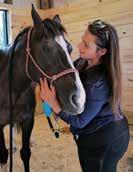
Fall Creek Falls Equestrian is a satellite adoption site for mustangs. Grace Grzegorczyk brushes a horse in a stall there. See story Page 12.
BTC Fiber is proud of our employees and happy to pass along our customers’ praise. Here are just a few of the messages we have received lately: Sharon N. has this to say about what we have to offer and service tech
Matthew Holland: “Just a note to say ‘thank you’ for your excellent service. The service tech (Matthew Holland) sent


BTC Fiber CEO/ General Manager Charlie Boring has been named president of the Tennessee Broadband Association. The nonprofit organization promotes telecommunications services across the state, serving approximately 240,000 access lines.
Working with legislators and government leaders, TNBA advocates for rural Americans, creating pathways for better telecommunications access and making impactful changes that will benefit future generations.
“As president of the Tennessee Broadband Association, I am dedicated to serving this cooperative, its members and residents across Tennessee,” Boring says. “I am honored to take on this role and look forward to advancing connectivity across our great state, empowering rural communities through advanced telecommunications solutions.”
to our home this a.m. not only quickly fixed our immediate problem, he went above and beyond to answer my questions regarding our TV reception. He offered a few possible remedies and made a few adjustments to our set. He was very polite, thorough and knowledgeable. You are very fortunate to have GOOD people like him in your service department!”

BTC Fiber is excited to sponsor the Sequatchie Valley Walk for Alzheimer’s at 9 a.m. on Saturday, Sept. 14. Cooperative employees will also be taking part in the 2-mile walk on the Dunlap Greenway. Entry fee is $25.
The Tennessee Council of Cooperatives is a nonprofit organization established to promote the cooperative way of business through education and promotion of all cooperatives in Tennessee.
Trevor S. reports that River Swafford did a great installation job. B. Thompson also benefited from River’s fine work, saying, “River did a fantastic job on our fiber upgrade.”
J. Bouldin says, “PJ (Johnson) did such a good job, so nice, professional, knowledgeable, just a great person.”

BTC offices will be closed on Monday, Sept. 2, to recognize Labor Day.

Cooperatives serve more than 75% of Tennessee’s rural residents. Unlike other businesses, a co-op is owned by those it serves and exists to meet the needs of its members as economically as possible. Tennessee cooperatives—like BTC Fiber— improve the well-being of rural residents and communities across the state by providing electric, internet and telephone services. They are also making significant investments to bring broadband service to the state’s unserved and under served areas.

Story by KATIE TEEMS NORRIS
For many, October isn’t complete without spine-tingling ghost stories, and chances are your hometown has a few of its own. Allison Jornlin, co-founder and tour developer with American Ghost Walks, conducts research and writes ghost tour scripts in towns across the United States. Allison is also a paranormal investigator and speaker, and
she’s been featured on the CW Network’s “Mysteries Decoded.”
Ghost tours are immensely popular, and Allison says they can be found in almost every large city and even in many small towns across the country. “I think people have lost their connection with history and with their ancestors, and this is a way to reconnect,” she says.

Unlike haunted house attractions that have terrifying special effects, ghost tours offer authentic history in locations that give guests the chance to literally step into the paranormal. They allow people to connect to the haunted past through walking tours, bus/trolley tours, investigation-style tours and even pub crawls. Some guests report experiencing
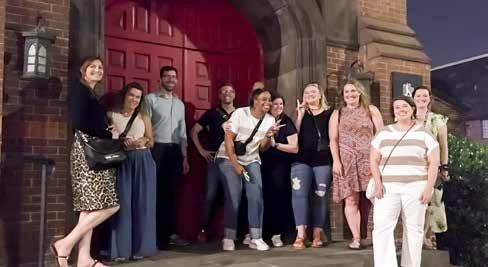

paranormal phenomena, like feeling unexplained cold spots or photographing disembodied faces and shadowy figures.
Allison pores through old newspapers and historical archives and interviews local people to give her tours as much local flavor as possible. “I’m looking for stories that are unique to the community that they come out of,” she says. While many stories across the country have common themes, Allison says, every place is a little bit different.
“You don’t have to believe in ghosts to enjoy the tour,” she says. Skeptics can have fun learning spooky stories. Tour guides often encourage guests to share their personal paranormal experiences to relate to one another. Ghost tours can’t guarantee guests will have an otherworldly encounter, but there is always a possibility.
If you’re ready to test your luck, consider joining these popular local tours, if you dare:
l Charleston, South Carolina’s, rich history, fascinating places, people and landmarks bring with them incredible stories—and lots of ghosts. Check them out through Bulldog Tours. bulldogtours.com/tours/ghost
l The Birmingham Ghost Walk in Alabama includes two walking tours and the Ghosts and Graveyards Chauffeured Experience. bhamhistory.com
l Old Louisville is home to what many consider to be the “most haunted neighborhood in America.” Learn why through Old Louisville Ghost Tours, in Louisville, Kentucky. louisvillehistorictours.com/louisville-ghost-tours
l Most ghost tours in the U.S. run year-round.
l Harpers Ferry, West Virginia, claims to have America’s oldest ghost tour. It began in 1970 and is still running. In 1973, historian Richard Crowe started Chicago’s first ghost tour. He told ghost stories on the radio around Halloween, which inspired Allison Jornlin and her brother to establish American Ghost Walks.
l Many ghost stories have common themes. Allison notes the prevalence of stories about women who met unfortunate ends. Guides across the nation tell local stories of jilted lovers, forlorn widows and vanishing hitchhikers.
Are you spending the spooky season exploring a new town—or your own hometown? A ghost tour is a fun way to learn about the history of a place and its people. Before you book one, follow these tips:
While each tour is unique, they typically fall into these categories: walking tours, bus tours, investigation tours and pub crawls. Investigation tours allow guests to become paranormal researchers for one night, and they typically focus on one building or property. A haunted pub crawl offers spirits of both the alcoholic and ethereal kinds.
Tour companies list important information on their websites, including an overview, length of the tour, walking distance, accessibility, age-appropriateness and cancellation/refund policies. Many tours encourage guests to purchase tickets in advance.
Check Google reviews and websites like Yelp or Tripadvisor for reviews. Search for detailed reviews that weigh the pros and cons of the tour. If you find positive reviews of a specific guide, you may be able to book a tour on a night when that person is working.
If you still have questions after your research, don’t be afraid to give the tour company a call.
Story by MELANIE JONES
Challenge 22 is making a difference in the lives of veterans in the Sequatchie Valley and across the nation. It’s not only changing lives, it’s saving lives.
The organization takes its name from a 2012 study by the Department of Veterans Affairs that found 22 U.S. veterans died by suicide every day. With the help of programs like Challenge 22, that number is down to 18.6. It is still far too high. Challenge 22 holds fundraising walks every year to benefit agencies that treat post-traumatic stress disorder and traumatic brain injuries through support rather than just through medication.
The organization began in Florida, and Lawana Perry, the wife of a non combat
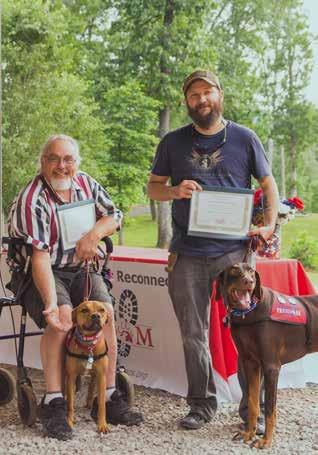
veteran, was on the original committee. When she moved to Sequatchie County in 2022, Lawana became friends with a neighbor who is a veteran, and she soon learned four veterans in the area had taken their own lives within about six months. She knew she had to do something.
Lawana reached out to the local Veterans of Foreign Wars and American Legion posts about expanding Challenge 22 to Tennessee. “There was a lot of awareness about the problem already,” she says, “but they didn’t know what to do about it.” Lawana knew what they could do.
With only two months of preparation, Lawana and co-chairman David Carter launched Sequatchie County’s first Challenge 22 walk in 2022 with the American Legion as its sponsor. She lined up 30 vendors and 75 walkers. The event took a hit, however, because it turned out to be the coldest day in Sequatchie County history. That didn’t stop Lawana. “We made $3,000 after expenses,” she says, adding the event would have raised more if the weather had cooperated.
A portion of the money raised stays in the Sequatchie Valley to assist families
Saturday, Sept. 7
8 a.m. registration, 9 a.m. walk
For more information, follow Challenge 22 Dunlap on Facebook.
of veterans who have died by suicide and to help veteran-to-veteran programs. The rest goes to prescreened nonprofits helping combat vets heal from post-traumatic stress. This year’s walk is set for Sept. 7.
One such program is Warrior Freedom Dogs, which provides service dogs to veterans in Tennessee, Georgia and Alabama. Charlie Brill donated two dogs, Oscar and Tango, on behalf of Challenge 22, as well as four other golden retrievers, Cash, Mike, Storm and Trooper.
Julie Jones-Thornton, the program’s training director, says the organization trains dogs specifically to help veterans experiencing post-traumatic stress, anxiety, panic attacks, dissociation or other symptoms of trauma after combat.
Puppies in the program are fostered the first year but come in every week for puppy training. After that first year, they train at the center for another year, followed by several months of training with the veteran.
After a veteran applies for a dog through the Warrior Freedom Dogs website, Julie sits down with the applicant one on one. “It allows me to have some

communication with them to see if a service dog will actually benefit them,” she says. Some people think a service dog will help, only to later realize that caring for the animal can add to their stress.
Once a veteran is paired with a dog, they go through 12 weeks of training together—first in a group with other veterans, then individually to train the dog to meet each veteran’s specific needs. After graduation, they remain with the program for a year, coming back to receive more training. That allows the veterans receiving dogs more time to interact with others, especially mentor veterans who have already been through the process. “We want them to learn to engage again,” Julie says. “It’s priceless for them to connect with other veterans.”
Veterans who experience trauma often isolate themselves. “The dog kind of bridges the gap and helps them reconnect,” Julie says. “It allows them to connect with a living being again.”
The dog trainer says she once worked with a veteran who was on 30 different medications, mostly for post-combat trauma, when he came in. Within six months of having a dog, his medication list was cut in half. “It’s not a cure-all, and it’s not for everyone, but when it works, it’s a miracle,” Julie says.
It’s not a cheap miracle. The organization provides everything to veterans for free, from the dogs to the training to veterinary services before the dog is transferred, to the beds, crates, leashes, harnesses and all the supplies the veteran will need to care for the dog once they get it home. From start to finish, the costs add up to about $25,000 per dog.
“We don’t have a great deal of overhead or administrative staff, so almost every

person here is a ‘boots on the ground’ front line person directly involved with the dogs and veterans,” Julie says. Every staff member is also a donor—whether it’s a monthly or annual donation or buying supplies for the dogs.
“Every penny counts,” Julie continues, “and even small monthly donations make a difference and help us continue to provide this priceless service to our veteran community.”
That’s where Challenge 22 can come alongside them and help with support. By supporting Challenge 22, individuals support Warrior Freedom Dogs and programs like it that help veterans who are hurting.

Story by DAVID HERDER and DREW WOOLEY
For much of her life, Olivia Murphy focused on becoming a collegiate swimmer. The biggest obstacle she faced didn’t come in the pool—it was catching the eye of college coaches.
Each year thousands of student-athletes pursue college athletic scholarships. Ultimately, only about one out of every 50 succeeds, according to a 2021 study by Next College Student Athlete. That bar can be even tougher to clear for athletes like Olivia, who live in rural areas, where it’s often difficult to get the attention of major programs.
For those students, earning a spot on a college roster takes more than just the talent and commitment to be a high-level athlete—it also takes a “second job” as a communicator and organizer, working just to be seen.
“I didn't start the actual recruitment process until summer of my junior year, which is a little late for some people,” says Olivia, a Tennessee resident and 2024 Tullahoma High School graduate.
Olivia’s path was more straightforward than that of many other athletes: Swim fast, win races. A key member of the Wildcats’ school-record-setting relay team, she recorded plenty of fast times while helping the team win its first division title.
She knew she had the speed, she just needed the coaches to know it, too. “When you first reach out to a coach, whether it’s through a questionnaire or an email, you put your best events and your best times in there,” Olivia says.
When prospective recruits submit statistics, coaches compare their times to those of their current swimmers, as well as the
ones winning division and national titles. Athletes from almost every sport send out these cold-call emails to coaches across the country. In sports like football and basketball, where skills can’t be boiled down to a set of times or statistics, athletes will create their own highlight videos and send those to coaches.
This can be especially valuable for rural athletes. Coaches can’t visit every town to scout athletes, but there’s no travel time in opening an email. Olivia says coaches especially want to see the swimmers’ videos. “They love videos,” she says. “Most coaches like to see video because they want to see your technique or where your weaknesses might be.”
Sometimes, rather than sending videos, recruits travel to camps and showcases so coaches can watch them in action and compare their skills to athletes at a similar level. These are often sport-specific camps run by college programs where potential recruits get hands-on practice time with
by
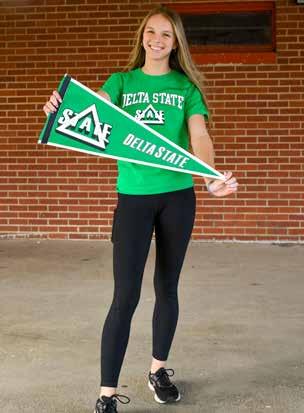
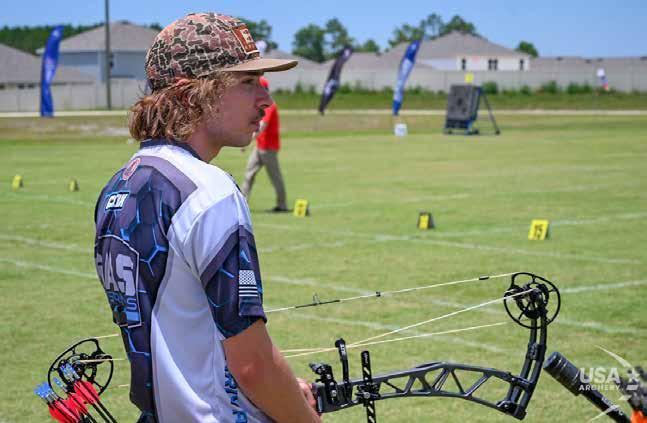
coaches. At regional showcases or tournaments, thousands of athletes can test their skills while scores of coaches look for diamonds in the rough.
Landyn Cox, a 2024 high school graduate from McKee, Kentucky, competes in archery and found success at these large events since most high schools don’t have archery teams. He was offered a scholarship to be an archer at the University of the Cumberlands in Williamsburg, Kentucky. He competed on the USA Archery U18 Compound National Team, the World Archery 3D Championships and other USA Archery Team events. He says the USAT events are a solid way to draw attention. “If you win like one of the USATs or certain big events, that gets your name out there pretty fast,” he says.
Once coaches begin recruiting, the challenge comes in settling on a school. Olivia narrowed down her list to three. “I wanted to limit myself to three visits because I’m really bad at decisions,” she says.
Part of the process was deciding what size school she wanted to attend. Many athletes feel the need to compete at a prestigious NCAA Division 1 school, but they
1. Know your skill level and learn the NCAA or NAIA eligibility requirements.
2. Compile an athletic resume with:
l Skills video
l Athletic stats
l Academic transcripts, ACT/SAT scores
l Extracurricular activities
3. Email coaches.
l Include your athletic resume.
l Subject line: Name, position, current grade level and key stat: “Jane Doe, High School Sophomore, Pitcher, 90 mph fastball”
l Individually craft each email, clearly stating why you’re interested in that program.
4. Make campus visits and meet coaches. Keep sending updated stats.
5. Lock down your offer and negotiate your amount. Don’t discount merit-based, academic or other scholarships.
could find a home—and potentially more playing time or better financial aid—at a smaller school. “Division 1 isn’t everything,” Olivia says. “It’s not live or die.”
No matter the size or program, a visit is the critical component. After a successful recruiting visit where she got along great with her future teammates, Olivia chose Delta State University, a Division II school in Cleveland, Mississippi.
“They need to go where they feel like they best fit,” she says. “I was like,
‘There’s no way that I’m not going to go Division 1,’ and then I found a school that matches up with Division 1 schools and I got better scholarship offers and felt like I fit with the team better. And so, I was like, ‘Oh, that’s not the end of the world.’”
But it will be a whole new world for Olivia, Landyn and other rural athletes as they aim to parlay their hometown successes and hard work to the next level.

Story by MELANIE JONES
Every few months, dozens of people camp out in their cars in a Pikeville parking lot, chattering with excitement over what morning will bring. They’re not waiting for tickets to the next blockbuster movie or concert. They’re there for the chance to adopt a mustang at Fall Creek Falls Equestrian. The farm is a satellite location for Bureau of Land Management Wild Horse and Burro adoptions. Rebecca Bowman, a longtime horse trainer who owns Fall Creek Falls Equestrian, started working with the BLM in 2009 in Atlanta before moving to the Tennessee location in 2020.
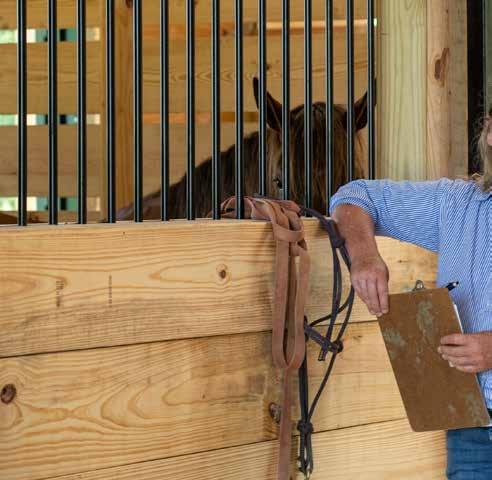

“It grew massively when I moved up here, mainly because of COVID,” she says. During the pandemic, the BLM couldn’t host its own adoptions, so it depended on satellite locations like hers.
While people tend to associate wild horses with the American West, Rebecca says mustangs’ popularity isn’t regional. “There


are a lot of people who love mustangs in the East,” she says. And people from all over the country come to her farm for the chance to adopt a wild horse.
Programs like Rebecca’s are important because they get horses and donkeys to good homes, says Shayne Banks, deputy district manager for the BLM-Southeastern States District Office.
There are 80,000 to 90,000 horses and burros in the wild and another 50,000 in long-term BLM holding. They roam the West, which is plagued by heat and drought. And, Rebecca points out, left on their own, the population would double every two to five years.
“We have millions of acres for them to roam,”
Shayne says, “but not enough food and water.”
So, the animals are brought to places like Fall Creek Falls Equestrian, where prospective owners fill out applications and go through interviews before they’re allowed to adopt the mustangs and take them home.
BLM representatives follow up after a year to make sure it’s still a good match. For the first year, Shayne says, the animal still belongs to the federal government, and BLM representatives will visit new owners. If an adopter does not meet obligations, finds training a mustang to be too much to handle or if circumstances change and they can no longer keep the horse, possession reverts to the government.
To Shayne, the popularity of mustangs is obvious. “They’re like Lay’s potato chips,” he says. “You can’t have just one.”
But, Rebecca says, adoptions are limited to four animals per person per year, and many take the limit.
Fall Creek Falls Equestrian doesn’t just match horses with adoptive families and send them on their way. It offers paid clinics led by established experts on how to train a mustang, as well as a few free demonstrations.
Mustangs aren’t for adults only. This year, Rebecca launched a competition for children and teens who have adopted and gentled mustangs and burros. The competition, named America’s Next Top Youth Trainer, features categories for kids ages 8 to 18 with $30,000 in cash and prizes.
It’s not just about the prizes. Learning to train horses at a young age can lead to a lifelong career. Just ask Grace Thompson of Graysville. Grace, 23, is now a professional mustang trainer. She got her first mustang in 2018. “I’m a very challenge-minded person,” she says. “I love the constant chance to grow as a horseman and to grow as a human.”
You don’t have to be a horseman to visit Fall Creek Falls Equestrian. Horse lovers often attend the adoption events just to see the animals and watch the demonstrations. The farm is also home to three vacation rentals.
You really don’t even have to visit the farm to see the horses. You can see one of Rebecca’s mustangs if you watch “Avengers: Endgame.” She’s also had horses cast in “Jungle Cruise,” “Chaos Walking” and “Lovecraft Country.” Rebecca is always looking for new ways to showcase horses and has revamped the arena at Fall Creek Falls Equestrian. She added obstacles and plans to hold jumping and dressage events. All kinds of horses will take part, but she makes sure to include mustangs in the mix.
“Mustangs are very intelligent horses,” she says. “They can learn any discipline.”
Shayne agrees. “They can do Western style, they can do English style, they can do dressage, they can jump. They can do absolutely anything any other horse can do,” he says. “They just need time and patience to get them there.”
Fall Creek Falls Equestrian does not offer trail rides. For that, owner Rebecca Bowman recommends Fall Creek Falls Riding Stables. It opens at 9 a.m. daily with the last ride going out at 5 p.m. The trail takes 45 to 50 minutes. The price is $40 per person. No reservations needed. For questions, call 931-946-1969, or visit fallcreekfallsridingstables.com.

It’s time to think about tailgating. Even if you aren’t a football fan, you can enjoy the food that goes along with the big game, from pots of chili to tater skins and Buffalo wings.
But these tailgating treats may not agree with your waistline. There are healthy alternatives to consider for lightening up your football spread without sacrificing taste. You’ll score some touchdowns yourself.

Food Editor Anne P. Braly is a native of Chattanooga, Tennessee.
Photography by Mark Gilliland
Food Styling by Rhonda Gilliland
4 boneless chicken breasts (2 to 2 1/2 pounds)
1 teaspoon dried basil
1 teaspoon salt
1 teaspoon onion powder
1/2 teaspoon garlic powder
1 teaspoon dried thyme
1 teaspoon dried parsley
1 tablespoon butter
2 tablespoons olive oil
1 large onion, chopped
3 stalks celery, chopped
3/4 cup chopped red bell pepper
2 cans whole green chilies, chopped (see tip)
3-4 cans cannellini beans, drained and rinsed (see note)
2-3 teaspoons cumin
1 cup sour cream
1/2 cup heavy cream
1/2-1 cup chopped fresh cilantro
1/2-1 cup grated Monterey Jack cheese
Additional chicken broth, if needed
In large pot, add chicken breasts and completely cover with water (4-6 cups).
Simmer chicken breasts with basil, salt, onion powder, garlic powder, thyme and parsley until completely cooked.
Remove chicken from broth and let cool. Reserve the seasoned broth for the chili. Once chicken is cool, chop and set aside. In a large stock pot, add butter and olive oil, and saute onion, celery and bell pepper until vegetables are translucent. Add chopped chilies and two cans cannellini beans. When mixture is warm, mash beans with a potato masher. Add 2-3 cups of the reserved broth, chopped chicken, cumin and 1-2 more cans cannellini beans. Let simmer 30 minutes to an hour. If mixture becomes too thick, add more broth. Add sour cream, heavy cream and fresh cilantro, and stir well. Taste and adjust seasonings, such as salt and cumin. Just before serving, stir in grated Monterey Jack cheese and ladle into serving bowls.
Tip: You will get better quality if you buy the whole chilies rather than chopped chilies.
Note: Progresso brand provides a better-quality bean that holds up well as the chili simmers, and you should only need three cans. If you use another brand and find that it is disintegrating as the chili simmers, add a fourth can of beans.

These delicious wings are oven-baked.
1/2 cup all-purpose flour
2 tablespoons garlic powder
2 teaspoons ground pepper
3 large eggs, beaten
1 1/2 cups panko breadcrumbs
1 1/4 cups grated parmesan cheese
2 pounds chicken wings, cut at joints, wing tips discarded
3 tablespoons balsamic glaze (storebought or made from scratch)
Lemon wedges
Ranch dressing
Celery and carrot sticks
Preheat oven to 450 F. Line a baking sheet with parchment paper. Coat with cooking spray. Combine flour, garlic powder and pepper in a shallow dish.
This recipe from Eating Well could be the creamiest hummus you’ve ever tasted. It’s best made a day in advance.
8 ounces dried chickpeas (about 1 cup)
1 tablespoon baking soda
7 large cloves garlic, divided 1/2 cup extra-virgin olive oil, divided 1/2 cup tahini, divided
1/4 cup fresh lemon juice plus 1 tablespoon, divided
1 1/2 teaspoons kosher salt
1/4 teaspoon ground cumin, plus more for garnish
Paprika for garnish
1/4 cup chopped flat-leaf parsley
Place chickpeas in a medium saucepan and cover with 2 inches of water. Stir in baking soda. Soak overnight. Drain the chickpeas and rinse well. Rinse out the pan. Return the chickpeas to the pan and cover with 2 inches of fresh water. Add garlic. Bring to a boil. Keep at a rolling boil until the chickpeas are tender and almost falling apart, 25-40 minutes.
Reserve about 3/4 cup of the cooking water, then drain the chickpeas. Set aside
2 tablespoons of the prettiest chickpeas for garnish. Rinse the remaining chickpeas and garlic and set the colander over a bowl. Refrigerate the chickpea mixture, reserved cooking water and pretty chickpeas separately overnight.
The next day, combine the chickpeas, 6 of the garlic cloves and 1/2 cup of the reserved cooking water in a food processor (or blender) with 1/4 cup each oil, tahini and lemon juice. Add salt and cumin. Process until creamy. Transfer to a serving bowl. Puree the remaining 1/4 cup each oil and tahini with the remaining garlic clove, 2 tablespoons of the cooking water and 1 tablespoon lemon juice until smooth.
Make an indention in the center of the hummus and spoon in the tahini-lemon mixture. Sprinkle the hummus with cumin and paprika, if desired. Garnish with the reserved whole chickpeas and parsley. Serve with fresh carrots, celery and other colorful vegetables and/or pita chips.
Place eggs in a second shallow dish. Combine panko and cheese in a third shallow dish. Working in batches, dredge chicken pieces in the flour mixture, then the eggs and finally in the panko mixture, shaking off excess after each dredging. Place on the prepared baking sheet. Coat the chicken lightly with cooking spray. Bake, turning the chicken halfway through, until the chicken is golden brown, and an instant-read thermometer inserted in the thickest portion registers 165 F, 20-25 minutes.
Arrange the chicken on a platter. Drizzle with balsamic glaze and serve with lemon wedges and ranch dressing for dipping with celery and carrots.

